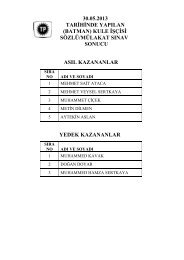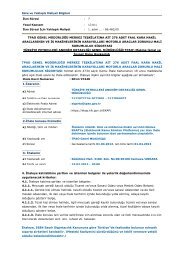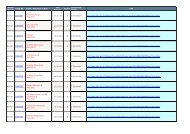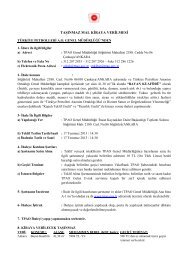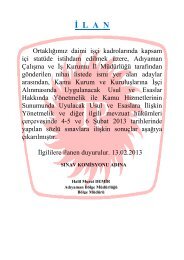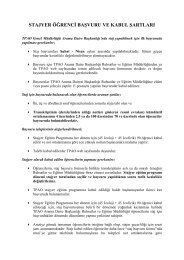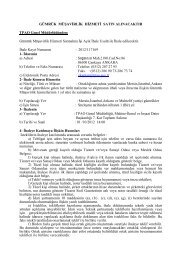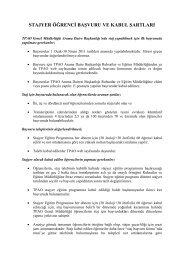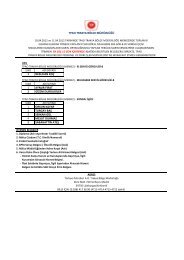5 - TPAO
5 - TPAO
5 - TPAO
Create successful ePaper yourself
Turn your PDF publications into a flip-book with our unique Google optimized e-Paper software.
the Accounting Standards (including those<br />
which adapt the IAS/IFRS application). In line<br />
with this decision, the Standard on “Financial<br />
Reporting in Hyperinflationary Economies”<br />
(“IAS/TMS 29”) released by the IASB was not<br />
applied as of January 1, 2005.<br />
1.3 Comparison of the Previous Period<br />
Financial Statements<br />
Comparison information was classified<br />
for the purposes of conformation with the<br />
presentation of the current period financial<br />
statements if necessary.<br />
1.4 Basis of Consolidation<br />
Consolidated financial statements comprising<br />
<strong>TPAO</strong> (“Company”, “Parent Company”) and<br />
the partnership controlled by <strong>TPAO</strong>, have<br />
been prepared by considering the financial<br />
statements belonging to the year ending on<br />
31, December 2011. The subsidiaries are<br />
defined as the companies controlled by the<br />
Parent Company holding more than 50%<br />
of the shares and voting rights directly or<br />
indirectly within the scope of capital and<br />
managerial relations or having the right of<br />
electing the majority of the management or<br />
having the majority of the management over<br />
the subsidiaries. The power of control implies<br />
that Parent Company plays the efficient role<br />
over the decisions of the company (Subsidiary)<br />
regarding the financial and operational politics<br />
and the power of managing aforementioned<br />
politics for the purpose of benefiting from the<br />
operations of the pre-mentioned company.<br />
The companies those do not have supervision<br />
capability but whose 10%-50% of the shares<br />
controlled by the parent company are defined<br />
as Partnership.<br />
The subsidiaries and affiliated companies<br />
and their shareholding percentages at 31<br />
December 2011 are on the left page.<br />
The company’s shareholding percentage<br />
in KTM is shown in the financial statements<br />
by using equity method. The equity and net<br />
income attributable to minority shareholders’<br />
interests are shown separately in the balance<br />
sheet and income statement, respectively.<br />
The losses applicable to the minority are<br />
charged against the minority interest, so<br />
as not to exceed the minority interest in the<br />
equity of subsidiary. As the investment in KTM<br />
is classified as an associated company, it is<br />
accounted for on equity basis. Participating<br />
interest acquired in KTM is accounted for<br />
by the equity method. The equity method is<br />
a method of accounting whereby an equity<br />
investment is initially recorded at cost and<br />
subsequently adjusted to reflect the investor’s<br />
share of the net profit or loss of the associate<br />
(investee). Distributions received from the<br />
investee reduce the carrying amount of the<br />
investment. The recoverable amount of an<br />
investment in an associate is assessed and<br />
if there is an indication that the carrying<br />
amount of the associate may be impaired<br />
permanently adjustment is made to state it at<br />
its recoverable amount. The book value of<br />
the investment in the capital of subsidiaries<br />
held by the parent company has been off-set<br />
against the equity of the invested companies<br />
and all inter-company purchase and sales and<br />
all accounts receivable and payable balances<br />
have been eliminated.<br />
1.5 Changes in Accounting Policies<br />
If the changes in accounting estimates are<br />
about only one term, they are applied in the<br />
current period when the change was made, if<br />
they are about future terms, they are applied<br />
both in the period the changes were made<br />
and in the future periods, prospectively.<br />
There have been no significant changes in<br />
the accounting estimates of the Group in the<br />
current period.<br />
Summary of Significant Accounting<br />
Policies<br />
2.1 Revenue<br />
The group’s income consists of crude oil and<br />
natural gas sales and the revenues of various<br />
55





